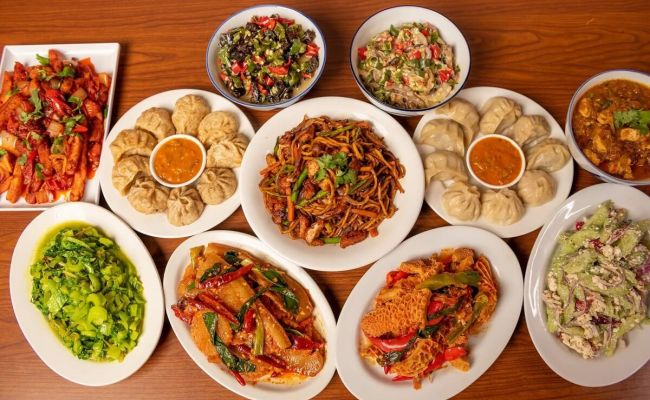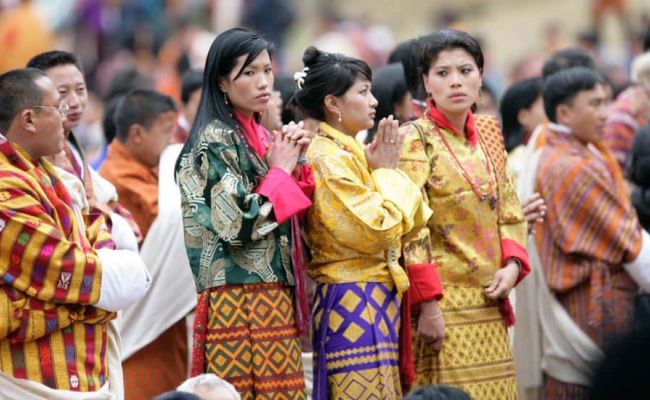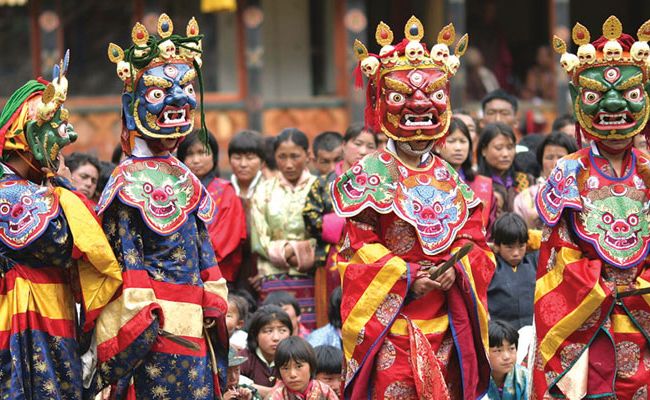Bhutan, formally known as the Kingdom of Bhutan, is a landlocked country in South Asia, located in the Eastern Himalayas between China and India. Bhutan has a population of over 727,145 and a territory of 38,394 square kilometers (14,824 square miles), ranking 133rd in land area and 160th in population. A king (Druk Gyalpo) and a prime minister govern Bhutan, a constitutional monarchy. Vajrayana Buddhism is the state religion, and Je Khenpo is its head.
Bhutanese culture today is based on old traditions. This culture influenced the country’s early development. Bhutan closely links its major languages, Dzongkha and Sharchop, to Tibetan, and its monks read and write an ancient form of Tibetan known as chhokey. Bhutanese are physically similar to Tibetans, although history does not record when they crossed the Himalayas to settle in Bhutan’s south-draining lowlands. Both Tibetans and Bhutanese worship Padmasambhava, the tantric guru who founded Himalayan Buddhism in the eighth century.
People Of Bhutan
Bhutan has three primary ethnic groups: the Bhutia (also known as Ngalop), Nepalese, and Sharchop. The Bhutia are the largest ethnic group, comprising over half of the population. They are descended from Tibetan immigrants who arrived in Bhutan around the ninth century. The Bhutia are the majority in northern, central, and western Bhutan. They speak a variety of Tibeto-Burman languages, the most popular of which being Dzongkha, Bhutan’s official language; the written language is similar to Tibetan. The Bhutia control Bhutan’s political life.

Religion Of Bhutan
Bhutan’s primary religion is Buddhism, followed by Hinduism. Consequently, sacred Buddhist principles heavily inspire Bhutanese culture. Bhutanese adhere to religious beliefs and highly regard their gods and deities. As a result, numerous monasteries, chortens, lhakhangs, and other religious structures exist throughout the country. You can find colorful prayer flags on hillsides, at the entrances to monasteries, and in other sacred places. Every district, or Dzongkhag, in the country, contains a Dzong, which is a unique blend of a fortress and a monastery.
Buddhist monks live in monasteries high in the mountains. They live a very modest life, without any luxury. A monk is often accepted into the monastery between the ages of six and nine, where he studies under a headmaster. Most families place a small offering to the deities on the floor before dining. So religion has a significant impact on people’s lifestyles.
Festivals of Bhutan
Bhutanese festivals are an exciting event in their lives and a vital component of Bhutan’s distinctive culture. The most prominent Bhutanese celebration is Tshechu. Every city has its own tshechu, which lasts three to five days. It occurs on a specific day of the lunar month (for example, the 10th day of the second lunar month). It is typically held in a dzong, when people from the entire district and adjacent areas come together in unity to participate in a mass celebration.
Masked dances, or chham, are the main attraction of a tshechu. Monks and laypeople dress up in silk robes and animal masks and perform dances depicting events from Guru Rinpoche’s life. The last day of the tshechu is usually marked by the unfurling of a silk thongdrel. Seeing the thongdrel is thought to wash away one’s sins.
Language Of Bhutan
Bhutan has two dozen languages, all of which are Tibeto-Burman, except for Nepali, an Indo-Aryan language, and Bhutanese Sign Language. Bhutan’s national language, Dzongkha, is the only native language with a literary tradition, even though neighboring countries have literary languages like Lepcha and Nepali. Other non-Bhutanese minority languages are spoken around Bhutan’s borders, as well as by the largely Nepali-speaking Lhotshampa group in South and East Bhutan. Chöke (also known as Classical Tibetan) is the language of traditional Buddhist monastic literature and learning.
Bhutanese Cuisine
Bhutanese cuisine is an intriguing and tasty excursion into the heart of the Himalayas. Bhutanese cuisine, known for its strong use of spices, distinctive ingredients, and deep connection to cultural traditions, provides explorers with a variety of pleasant experiences. From the spicy Ema Datshi, the famous national dish cooked with chiles and cheese, to the healthy and nutritious Bhutanese Red Rice, each component of the food tells a tale about Bhutan’s rich history. The food represents the healthy balance between nature and spirituality that is important to Bhutanese life, as it incorporates a varied range of traditional Bhutanese dishes, including both vegetarian and carnivorous options. Bhutanese cuisine, whether in the form of simple yet fulfilling Bhutanese street food, ceremonial Bhutanese festive foods, or the comfortable sip of Bhutanese butter tea, exemplifies the country’s attitude of happiness and well-being. Furthermore, the use of traditional beverages such as ara (Bhutanese rice wine) enhances the dining experience. Delving into Bhutanese cuisine is more than just savoring flavors; it’s an immersive trip through Bhutan’s rich food culture and traditions.

Traditional Dress- Gho And Kira
Bhutanese people traditionally wear gho and kira. The dresses are part of their cultural identity, yet the legislation requires government personnel to wear them. Gho refers to Bhutanese men’s traditional attire. The Kera, a cotton belt, fastens the knee-length cloth around the waist. For all Bhutanese men working in government offices or schools, Gho is required.

Zhanbdrung Ngawang Namgyel invented Gho to help people develop a unique identity that is connected to their culture. In Bhutan, women wear kira as their national dress. It’s an ankle-length garment with a piece of rectangular cloth wrapped, folded around the torso, and pinned to the shoulders. A long-sleeved shirt named Wonju and a short jacket named toego complement it.
